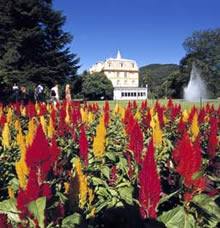
- GOLF
- VILLE E PALAZZI
- PARCHI, RISERVE NATURALI, ORRIDI
attraction Verbania
Villa Taranto
The gardens at Villa Taranto were designed by captain Neil Mc Eacharn who purchased the property in 1931 from Marquess Sant’Elia, to transform it into an English garden that would reconcile appearance with botanical needs, with the desire in some way to rebuild a corner that would remind him of his native Scotland.
The name was also chosen to honour the memory of the captain's ancestor Marshal McDonald, appointed Duke of Taranto by Napoleon. The huge job, which took 9 years to complete, encountered many difficulties, including acclimatising unique plants in Europe that were used to different soil and climates. A new irrigation system was also built, which allowed directly pumping water from the lake. Fountains and plays of water were created, along with terraced gardens, the winter garden, marshes and ponds for waterlilies and lotus flowers. Significant excavations in 1935 resulted in the romantic Valletta, dominated by a single-arch bridge. Here visitors come across the Davidia involucrata, picturesquely called the Handkerchief tree.
The botanical gardens at Villa Taranto: history
Captain Neil Boyd Mc Eacharn had been looking for two years for suitable land to create a large, heterogeneous garden. An add in the Times indicated that Marquess Sant’Elia intended selling a property called La Crocetta, located on the Headland of Castagnola in Pallanza, and so they came to an agreement. The following years, the captain dedicated himself to reorganising and repopulating the botanical garden that required seeds and young plants from all over the world.
When WWII broke out, Mc Eacharn was forced to leave Italy. He donated the property to the State on the condition that the gates not be opened to the public. At the end of the war, the captain returned to his beloved garden and decided to open it to the public in 1952 on the insistence of friends and several public bodies. Captain Neil Mc Eacharn died 12 years later (on his express request, he was buried in a chapel built in the garden, which was designed by professor Renato Bonazzi). From that moment on, the gardens have been managed by Ente Giardini Botanici Villa Taranto Cap. Neil Mc Eacharn with the purpose of preserving and promoting them internationally.
Botany at Villa Taranto
Villa Taranto’s botanical heritage now comprises some 1,000 non-native plants and 20,000 rare or valuable species harmoniously arranged on approximately 16 hectares. Paths of azaleas, camellias, maple trees and rhododendrons lead to gardens with over 300 varieties of dahlias and then to the greenhouses where the famous Amazon waterlilies (Victoria cruziana) is cultivated amongst tropical and sub-tropical plants. Some of the more rare species include the Dicksonia antartica and the already-mentioned Davidia involucrate, while the most common ones include the Eucalyptus, magnolia, Michelia, tulips, lotus flowers, heather, Dwarf Asters and the hydrangea.
Touring the botanical gardens at Villa Taranto
Villa Taranto (since 1996, the seat of the Prefecture of the Province of Verbano-Cusio-Ossola) was built sometime around 1880 by Count Orsetti in a style vaguely inspired by the architecture in Normandy. It is not currently open to the public. However, the botanical gardens can be visited from April to October; over 150,000 people come here every year to tour them including scholars and enthusiasts from all over the world. A rich calendar of events also accompanies the opening season. One of the most well-known is the La settimana del Tulipano (week of the tulip) held between the end of April and beginning of May.
Photo gallery Villa Taranto
















Follow @LagoMaggioreNet